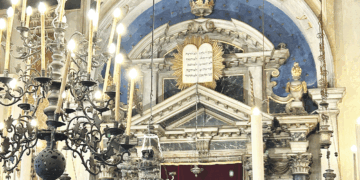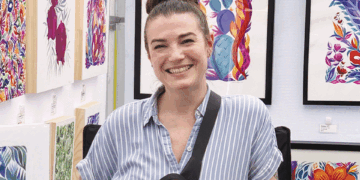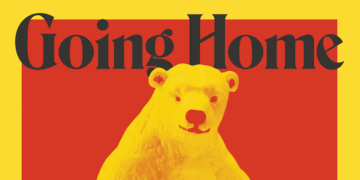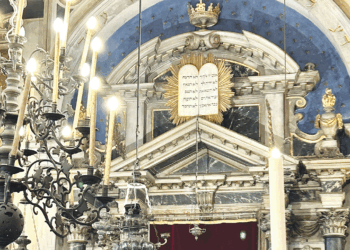by MAX SPARBER
Community News Editor
Brazilian-born artist Jônatas Chimen has a lot of story to tell, and that story has been the basis for a lot of art. He will discuss it at the final Rimon Artist Salon Series, April 29.
Chimen was born to a crypto-Jewish family in Brazil, although it would be a long time before he knew it. Crypto-Jews, also known as conversos (or Marranos, a name that some consider disparaging, although Chimen embraces it) are descendants of Jewish people in the Spanish empire who were forcibly converted to Catholicism, but privately maintained their Jewish practices.
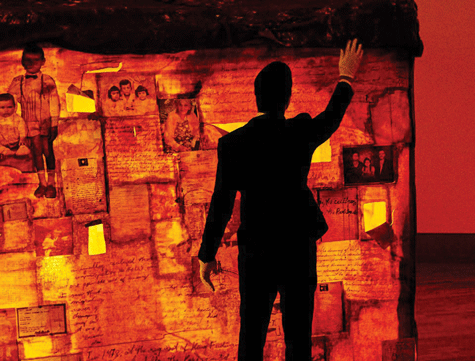
Out of necessity, crypto-Jewish families were secretive. Chimen’s parents hid his heritage from him, and it wasn’t until he was an art student in American that he started to question his heritage.
According to Chimen, he was working at a henna business in a mall. His mother came to visit, and his boss asked if she was Jewish, noting that her name was Miriam and Chimen’s is close to Yonatan, both Hebrew names. “That bothered me, because why are there people asking?” Chimen said in interview with American Jewish World.
Strangers continued to identify him as Jewish, and Chimen started to recall elements of his childhood that perplexed him. His grandparents were vague about their origins, identifying themselves as coming from Germany or Amsterdam, despite having last names that originated from Portugal. And there were odd family practices: Friday night dinners that friends suggested might be intended for the Sabbath; a dinner table with secret drawers, as though intended for diners to hide things at a moment’s notice, such as prayer books or ritual foods; a superstition that one should never point to a star on Friday night, or one’s finger might fall off.
Chimen continued to press his parents, and finally they confessed that they were, in fact, crypto-Jews, and had planned to tell him when he was older. Suddenly things made sense to him. The superstition against pointing to a star? “They were scare tactics to keep people from doing things that were clearly Jewish.” The Jewish Shabbat begins when there are three stars in the sky on the Sabbath eve.
What followed was a 10-year odyssey of education as to his Jewish heritage, as well as a similarly long attempt to have his status as a Jew recognized, all documented in his art. Chimen went from synagogue to synagogue, and although he was accepted as a member, he was repeatedly told that if he planned to marry within that synagogue, he would have to undergo an official conversion. The rabbis told him that this was to address any doubt, as, without an established family tree or a series of marriage contracts, it was impossible to know if his matrilineal history was consistently Jewish.
Chimen argued that this shouldn’t be necessary. His family, like many conversos, had maintained a long tradition of marrying near-relatives. Additionally, “I had family who died for being Jewish.”
In the meanwhile, Chiman scoured the historical records, trying to establish an unbroken timeline of his family. The documents eventually numbered in the thousands.
Finally, the chief rabbi of Israel announced that conversos should be welcomed back into Judaism with a different ceremony, similar to the conversion ceremony but recognizing that they have always been Jewish. This slowly became widely accepted among the various Jewish communities and congregations, and Chimen underwent the ceremony, with several other conversos, establishing him as being unquestionably Jewish. “I can’t even describe the kind of celebration we had,” he said.
Chimen work as a visual artist is by these experiences, which he sees having parallels in many immigrant experiences, describing his themes as “immigrant, adaptation and hybridization.” An example would be his piece “In Thy Tent I Dwell,” a literal and enormous tent made out of the thousands of documents he assembled to establish his identity. The piece has a profound transience, as one might expect from a tent, but also reaches far back into the past, detailing a long history of forced conversion, expulsion and migration. “My work is about what it takes to survive,” he said.
He added: “You become something new that might not be recognized by those left behind.”
***
Jônatas Chimen will discuss his experiences and art as the conclusion to the Rimon Artist Salon Series in Diaspora & Cultural Survival: A Crypto-Jewish Perspectiveat 2 p.m. Sunday, April 29 at Traffic Zone Center for Visual Art, 250 3rd Avenue North, Studio 332, Mpls. For information visit rimonmn.org or 952-381-3449. Additionally, Chimen will present his art at 12 p.m. Thursday, April 26, at the Iversen Hearth Room (Room 340), Anderson Student Center University of St. Thomas, 2115 Summit Ave., St. Paul.
(American Jewish World, 4.20.18)

